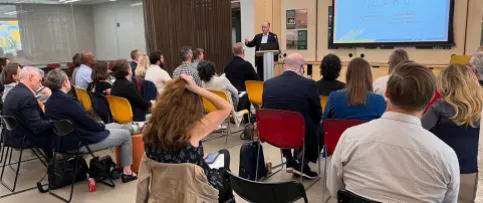Architect Danei Cesario, AIA, NCARB, shares advice for pursuing licensure and discusses her experience navigating the AXP and the ARE.
Why did you want to become an architect?
Seventy percent of that decision happened on my way home from school. I was about six or seven, and I was fascinated by this massive church at the top of a steep hill. I bombarded my mum with questions on how it was built, who built it, why, and when. The other 30 percent occurred in transit. I grew up on both sides of the Atlantic, and seeing the shift in scale from my native town in Manchester, England, to skyscrapers in Manhattan carried an element of awe for me. Every space, regardless of scale, held a certain memory for each person. So, I chose to follow a career that allowed me to make space for people to make memories in.
How long did it take you to complete your experience and exams? What was your strategy?
I completed my work experience roughly two and a half years after I graduated from university, in part because I started my NCARB Record as soon as I was eligible. I worked in an expediting firm (a firm that specializes in making the design and construction process go as quickly and smoothly as possible) while I was in college and was fortunate to gain a wide range of experience in various areas during that time.
In my first post-graduate job, I explained my NCARB experience goals to my manager during the interview. With her support, I regularly sought out experience opportunities and diligently logged my hours. Again, firm type played a pivotal part in completing the program (called the Intern Development Program, or IDP, at the time). My job was in a multi-disciplinary Fortune 500 engineering/architecture firm, and the structure of the organization provided valuable opportunities to work with and learn from engineers.
Start to finish, the exam process took about 18 months with a few long lapses. I eventually found that momentum was my greatest ally and passed five exams in four months. I also booked the exams before I felt 100 percent ready to take them. For me, this set a solid date to study toward.
Do you have any study tips?
Studying is very personal and should be catered to how you learn and retain information best. I found study groups ineffective, and was most effective when I studied for no more than two-hour blocks. I also found it helpful to read the textbook, highlight key points, and then transcribe them into my own hand-written notes with sketches to help make connections. When I faced setbacks, I remembered that inquisitive little girl at the top of a steep hill.
As a Black female architect, you are a member of two underrepresented groups in the architecture field. What has that experience been like for you?
Four under-represented groups: I am the 333rd Black female architect in the United States, an immigrant practicing in America, and a mum of two, [according to the Directory of African American Architects]! My experience as a member of all these groups has been a brilliant one because each experience has made me a stronger architect. Biased people may only see the obvious ways that I differ from the perceived norm in the architectural field and will dismiss me on those grounds alone.
I believe that our individual stories provide an additional layer of richness to the built environment, because we are using our collective experiences to inform empathetic spatial solutions for a diverse global population. On occasions when I have been underestimated for being Black/female/an immigrant/mother, I have not seen it as an opportunity to “prove them wrong.” I have treated those occasions as opportunities to prove to myself that I can accomplish another career milestone.
You’re the chair of AIA New York’s Diversity & Inclusion Committee. How do you think the architecture community can work to increase diversity?
Last year, we won the Committee Excellence Grant through our local chapter and dedicated the funds to researching that! We released the Equity, Diversity & Inclusion (EDI) survey to local members to quantify the current demographics and hosted a symposium to discuss the issues of attrition and diversity in our profession. Our aim is to create a framework that makes progress trackable and suggests improvements that are actionable for the architecture community. Our initial findings will be released during an Architect Live panel at the A’18 Conference on Architecture in New York. Stay tuned for the full report, which will be released at the end of this year!
I truly believe diversity, equity, and inclusivity can be achieved through a balance of engaging in communication and action. Through the Diversity & Inclusion Committee, we offer programs that foster exposure, education, and empowerment. For best efficacy, these three approaches need to become the norm in academia and in the workplace. We are working with professors and practice leaders to make this goal a reality.
How has becoming licensed accelerated your career?
Being a licensed architect simultaneously elevates your level of risk and your level of investment on a project. It helps to establish your abilities as a professional since everyone is being tested at the same level.
What advice do you have for candidates going through the licensure process?
- Reflect on what motivated you to get licensed in the first place. It’s important to pause and ask “why?”
- Stay inspired; it’s the best gift you can continuously give yourself.
- Take care of yourself—eat, sleep, and pace yourself properly.
- Keep your momentum in taking exams.
- Don’t take anyone else’s advice (ha!)
You’re also NCARB certified. How has holding the Certificate affected your career?
Although I am based in New York City, I am licensed in several other states. Having the NCARB Certificate has allowed me to take more of a leadership role on projects nationwide.
Danei Cesario is an Associate at Array Architects in New York, New York.



